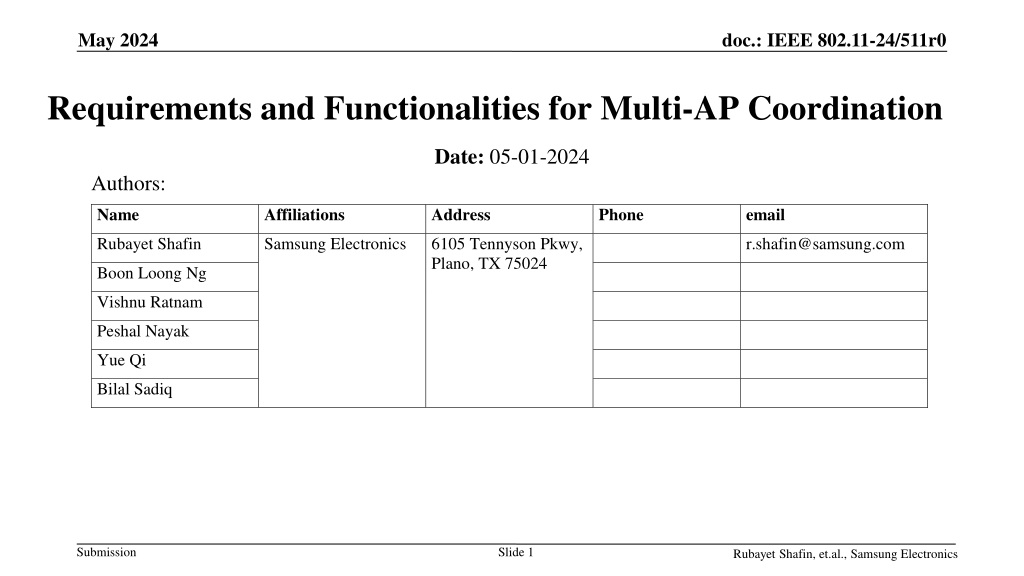

0 likes | 14 Views
Highlighting the importance of Multi-AP (MAP) Coordination for IEEE 802.11bn, this document discusses the various modes of MAP coordination such as Coordinated TWT, TDMA, Spatial Reuse, Beamforming, Joint Transmission, and more. It categorizes MAP contributions into Camp-1 and Camp-2, emphasizing the need to support both enterprise and non-enterprise scenarios. The document explores assumptions, use-cases, a generalized MAP framework, and proposes a general framework for coordination among multiple APs in IEEE 802.11bn.

E N D
May 2024 doc.: IEEE 802.11-24/511r0 Requirements and Functionalities for Multi-AP Coordination Date: 05-01-2024 Authors: Name Affiliations Address Phone email Rubayet Shafin Samsung Electronics 6105 Tennyson Pkwy, Plano, TX 75024 r.shafin@samsung.com Boon Loong Ng Vishnu Ratnam Peshal Nayak Yue Qi Bilal Sadiq Submission Slide 1 Rubayet Shafin, et.al., Samsung Electronics
May 2024 doc.: IEEE 802.11-24/511r0 Abstract In this contribution, we highlight the requirements and functionalities of multi-AP coordination for 802.11bn Submission Slide 2 Rubayet Shafin, et.al., Samsung Electronics
May 2024 doc.: IEEE 802.11-24/511r0 Introduction • Multi-AP (MAP) Coordination is one of the key features considered for IEEE 802.11bn. • By coordinating among overlapping BSSs, MAP coordination technology promises better network efficiency. • Different forms of MAP coordination have been discussed— • Coordinated TWT • Coordinated TDMA • Coordinated Spatial Reuse • Coordinated Beamforming • Joint Transmission • Coordinated Channel Usage • … Submission Slide 3 Rubayet Shafin, et.al., Samsung Electronics
May 2024 doc.: IEEE 802.11-24/511r0 MAP Contributions (Camp-1) There have been many series of contributions on MAP coordination These can be broadly grouped into two camps— Camp-1: Discusses the operations and dynamics of a particular mode of MAP coordination Example- RTWT: • What level of protection for RTWT SPs would be needed • Whether the APs-only or both the APs or STAs end the TXOP before the start of an R-TWT SP? • How a coordinated AP advertises an RTWT SP originated from a coordinating AP’s BSS • Whether the existing TWT element can be used or a new element would be needed Example- TDMA: • How to extend the current TXOP sharing framework to MAP • Whether a single trigger frame can indicate TXOP allocation to multiple users • Extension of MU-RTS TXS trigger frame • NAV protection rules • • • • • Submission Slide 4 Rubayet Shafin, et.al., Samsung Electronics
May 2024 doc.: IEEE 802.11-24/511r0 MAP Contributions (Camp-2) Camp-2: Discusses the same materials as in Camp-1, PLUS discusses or acknowledges the work on— • • How the APs discover each other for MAP coordination • How to negotiate MAP coordination parameters • How to modify or terminate an existing MAP negotiation Submission Slide 5 Rubayet Shafin, et.al., Samsung Electronics
May 2024 doc.: IEEE 802.11-24/511r0 Assumptions behind Camp-1 Some contributions avoid discussing the MAP discovery and negotiation phases • Central Controller Often the underlying assumption for Camp-1 is that MAP coordination is only applicable for managed/enterprise networks. • BSS1 In such a network, the APs are usually controlled by a central entity, which can dictate the coordination process among the APs it controls. The APs are often from the same vendor • Accordingly, the participating APs don’t need to go through any MAP discovery/negotiation steps. • AP1 AP2 AP3 BSS3 BSS2 Submission Slide 6 Rubayet Shafin, et.al., Samsung Electronics
May 2024 doc.: IEEE 802.11-24/511r0 Camp-2 MAP use-cases MAP coordination can be a major work item for 11bn • Both the enterprise and non-enterprise/residential scenarios can benefit from MAP technologies. • The specification should provide the necessary tools so that even two APs from different vendors can use MAP coordination— • Tools to discover the participating APs • Tools to negotiate/maintain coordination terms and conditions • Disregarding the non-enterprise/residential use cases would be quite restrictive for MAP coordination technology. • Submission Slide 7 Rubayet Shafin, et.al., Samsung Electronics
May 2024 doc.: IEEE 802.11-24/511r0 Generalized MAP framework For different MAP coordination mechanisms, there can be some procedures/steps that are reusable for any mode of MAP coordination • Other steps/procedures can be specific to a particular mode of MAP coordination (C-TWT, C-TDMA, C-SR, JT etc.) • Parameter Negotiation Termination/ Modification Discovery Step-1 Step-n Generalized procedure Generalized procedure MAP mode specific procedure Example-CTWT: • MAP Coord. Announcement for TWT MAP Coord. Negotiation for TWT Intra-BSS TWT Announcement (BTWT/RTWT) MAP Coord. Termination for TWT Intra-BSS TWT Negotiation TWT Maintenance TWT-specific procedure Submission Slide 8 Rubayet Shafin, et.al., Samsung Electronics
May 2024 doc.: IEEE 802.11-24/511r0 Summary MAP coordination in 802.11bn should support non-enterprise along with the enterprise use cases. • The MAP framework can be generalized where some procedures can be common to all modes of MAP coordination (CTWT, CTDMA, CSR, JT, etc.) • Submission Slide 9 Rubayet Shafin, et.al., Samsung Electronics
May 2024 doc.: IEEE 802.11-24/511r0 SP1 - Do you want to define in 802.11bn a general framework for coordination among multiple APs? - The framework should support different forms of MAP coordination, e.g., C-TWT, C-TDMA etc. - The framework should allow two APs, not necessarily centrally managed or in the same ESS, to discover each other and negotiate on the coordination parameters. Submission Slide 10 Rubayet Shafin, et.al., Samsung Electronics